Rose pests need management techniques depending on their types and species. Caterpillars are among the most common pests on cultivated and wild roses along with aphids, mites, and thrips.
Young caterpillars only feed on the soft parts of rose leaves while many mature caterpillar species defoliate roses by eating entire leaves and even the flowers at times.
Table of Contents
Caterpillars That Eat Roses
Some of the most common rose caterpillars include the following species.
1. Eastern Tent Caterpillar
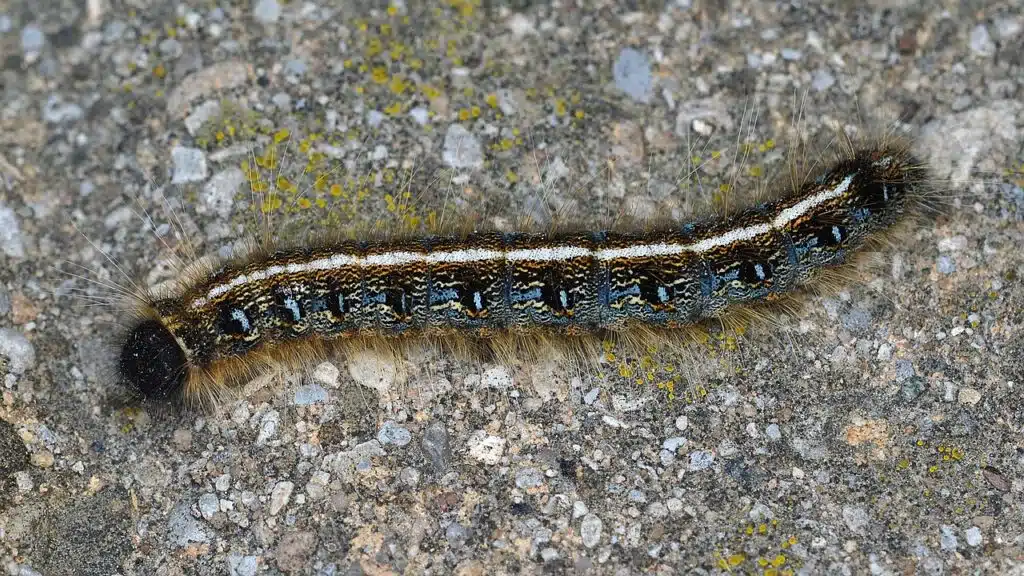
Eastern Tent Caterpillars (Malacosoma americanum) are among the species with the largest impact on roses. Moths lay eggs in clumps which later turn into caterpillars.
Damages caused by these caterpillars are the highest in their early growth stages when they live together.
Eastern Tent Caterpillars have a black color with a central dorsal white stripe which is bordered by blue spots.
Scarce lateral yellow hairs are also visible on the species.
This species builds silk tents and it also leaves silk trails wherever it goes.
Movements on host rose plants need to be monitored early as the species can completely defoliate its host.
Minor damages to hosts may not negatively impact roses as they can regenerate.
While not poisonous on roses, the Eastern Tent Caterpillar is poisonous to animals when growing on black cherry.
2. American Copper Underwing Caterpillar
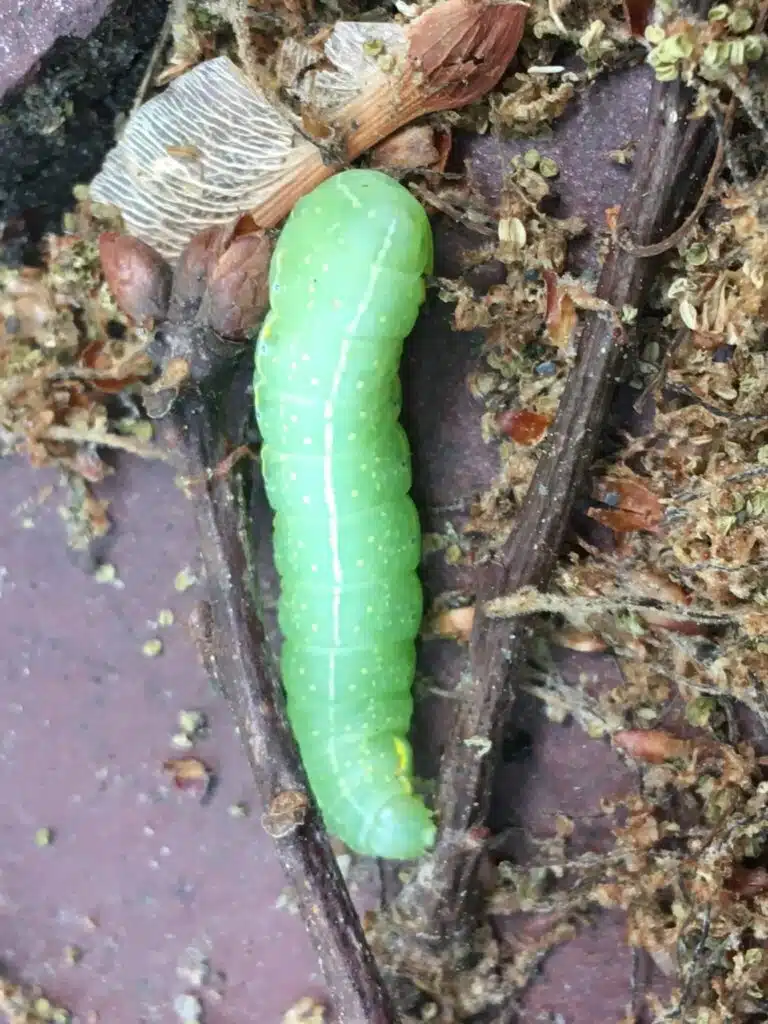
Some of the first signs of an American Copper Underwing Caterpillar (Amphipyra pyramidoides) invasion is rolled leaves.
Springtime is the period when these types of caterpillars are responsible for most damage to hosts.
Damages inflicted by this species aren’t solely tied to rose-family plants. It can also eat its way through the foliage of raspberry and maple.
The green color is specific to this caterpillar.
While uniformly green, the species still has nuance differences as it grows.
It has a light green nuance as emerges slowly turning dark green with lateral yellow lines as it grows.
The species turns into a brown-black pupa.
Caterpillars of this family are seen in one generation per year. They only rarely appear in 2 broods.
American Copper Underwing Caterpillars are already present on roses before spring as they overwinter in the egg stage of their lifecycle.
3. Spicebush Swallowtail Caterpillar
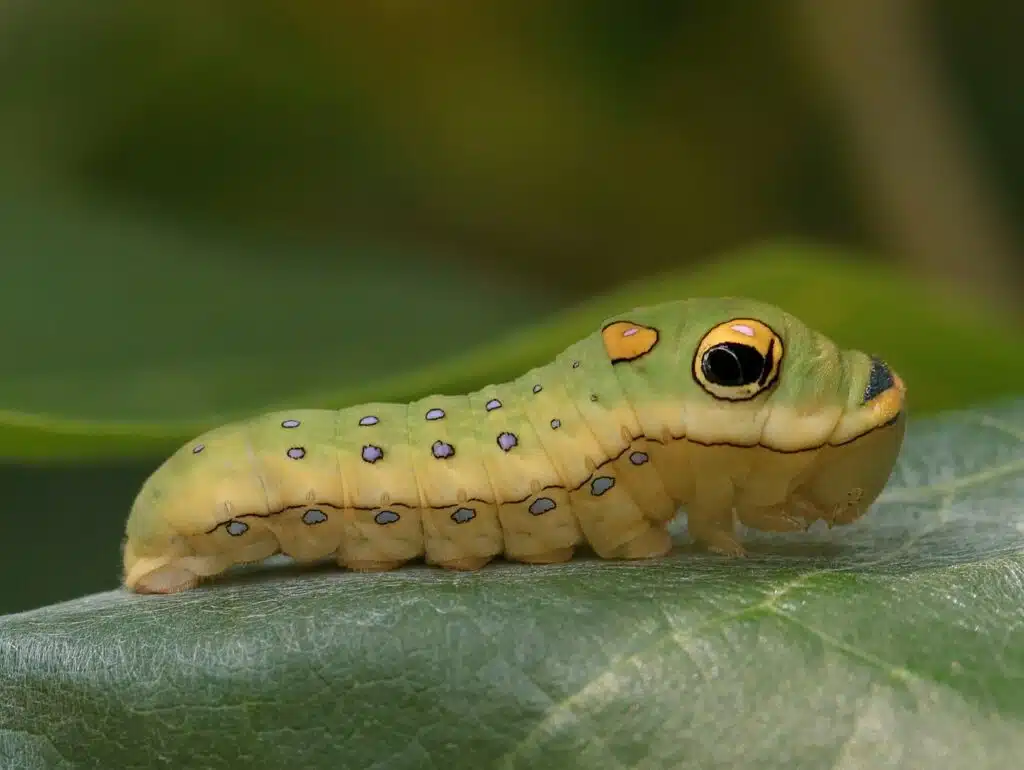
Rosacea-family plants are impacted by Spicebush Swallowtail caterpillars (Papilio troilus).
Native to Eastern North America, Spicebush Swallowtail have multiple hosts apart from roses such as magnolias.
Identifying this species is easy since Spicebush Swallowtail Caterpillars have 2 large eyespots to make them resemble small snakes.
They have a mostly dark brown color in their first days. This color turns to bird-dropping mimicry brown and yellow coloring.
As it matures, the species turns green on the dorsal side and brown on the ventral side.
Spicebush Swallowtail caterpillars spin silk mats which they use to curl host plant leaves to create a shelter.
Once the leaf is curled, birds and other predators move along without spotting them.
Once caterpillars turn yellow, it’s already a sign they are about to pupate.
Not many caterpillars of this species get to pupate. Many of them simply fall prey to predators such as tachinid flies.
4. Saddleback Caterpillar
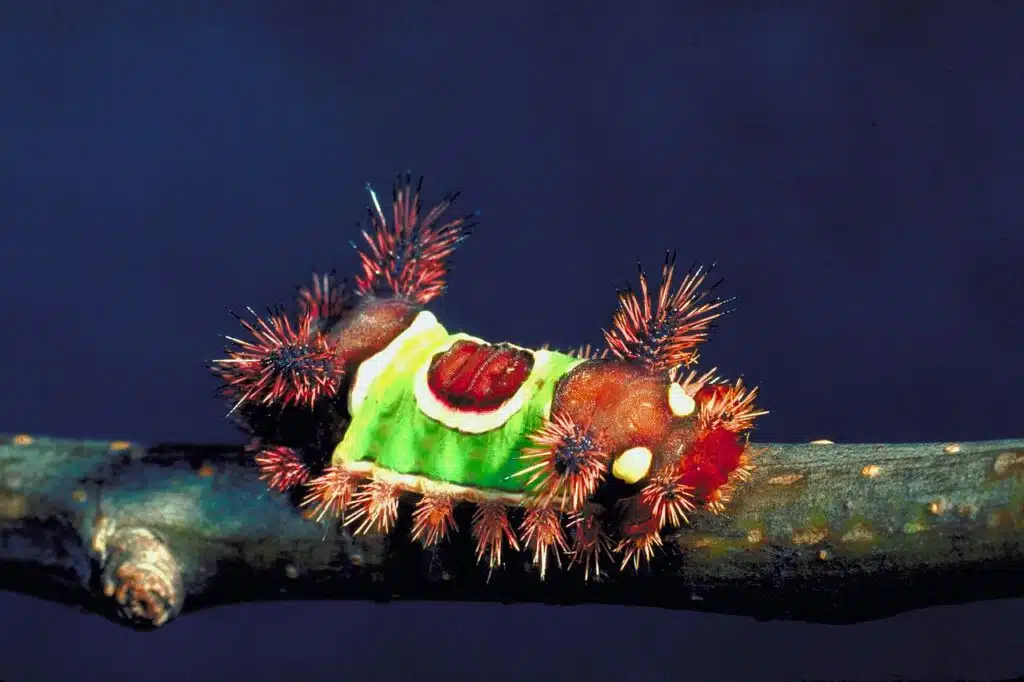
Roses and rosacea-family plants are among the common hosts of the Saddleback Caterpillar (Acharia stimulea).
The name of the species is derived from its saddle-like mid-dorsal coloring.
Saddleback Caterpillars have a green saddle on a brown ground color.
The species first appear yellow to green only turning brown and green as it grows.
Spines cover the body of the Saddleback Caterpillar so it should not be removed by hand from roses.
This species is known to cause red skin blotches or acute urticaria.
Rashes and redness are specific to the skin in the reactions caused by touching the Saddleback Caterpillar.
Saddleback Caterpillars should be immediately removed from rose plants as severe defoliators.
They can move along to various crops which they also defoliate.
Pesticides are used against the species as they can invade crops.
The number of hosts of the Saddleback Caterpillars can further expand from roses to decorative tree sand to hardwood trees such as hackberry.
5. Common Emerald Caterpillar
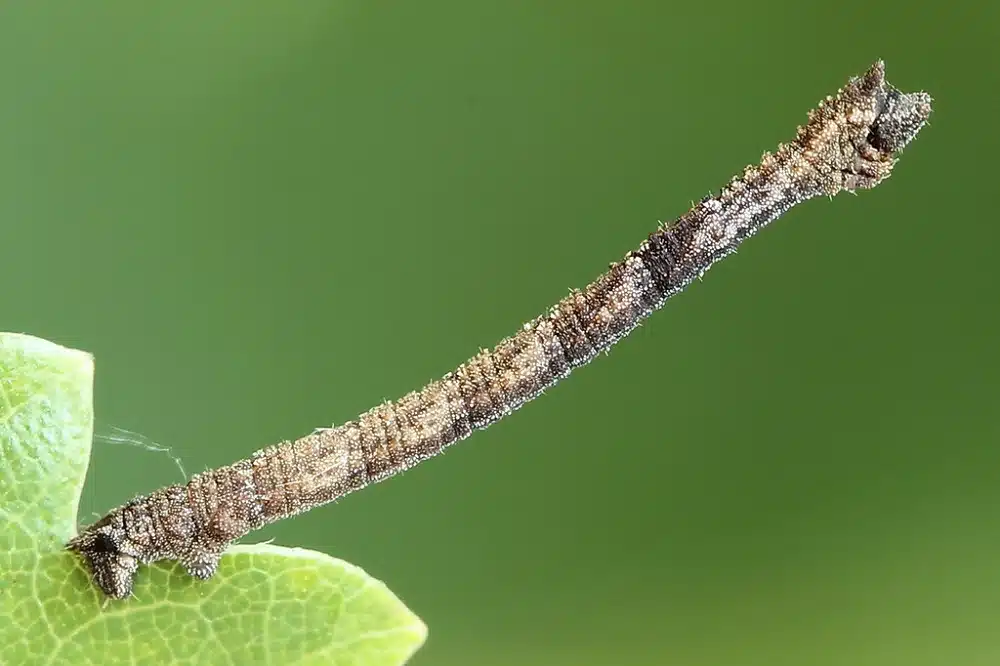
The widespread Common Emerald Caterpillar (Hemithea aestivaria) is named after the emerald color of the species’ moth.
Caterpillars of this family are among the common rose-plant feeders. They are also very common on other plants and various species of trees such as birch.
Common Emerald Caterpillars look like twigs or sticks. They have a green and brown appearance in a thin elongated body which might make some people overlook them on host plants.
Present in Eastern parts of North America, this species is known for its resilience as it even overwinters as a caterpillar.
Clearing vegetation and pruning trees are recommended apart from pruning roses to keep these caterpillars away.
These caterpillars can easily expand around the orchard or in the garden as they use multiple hosts as food.
Some of the rarest types of hosts the Common Emerald Caterpillars can be seen on include mountain ashes.
6. Common Marbled Carpet Caterpillar
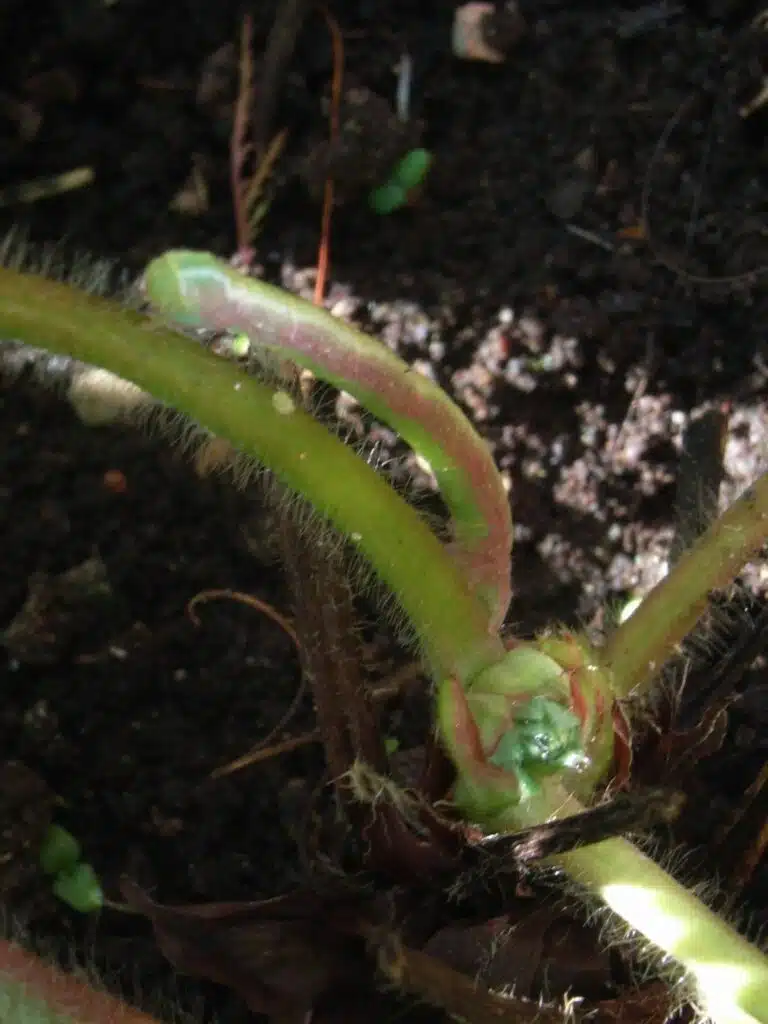
Common Marbled Carpet Caterpillars (Dysstroma truncata) have an atypical shape and coloring.
This species is mostly yellow or lime-yellow in its initial growth stages. It also has green prolegs which resemble the color of the leaves it fees on.
Feeding starts from its early growth stages and the species continues feeding and changing colors as it grows.
A dark green color is specific to the Common Marbled Carpet Caterpillar as it reaches its final growth stages.
Lateral red stripes are further distinguished on the body of the grown caterpillar.
These red colors are believed to be an adaptation of the species which makes them have camouflage coloring on hosts such as strawberry plants.
The list of hosts for the Common Marbled Carpet Caterpillar is long.
Honeysuckle and birch are some of its most common hosts alongside roses. This species migrates towards willow in the absence of suitable hosts.
7. Double-striped Pug Caterpillar
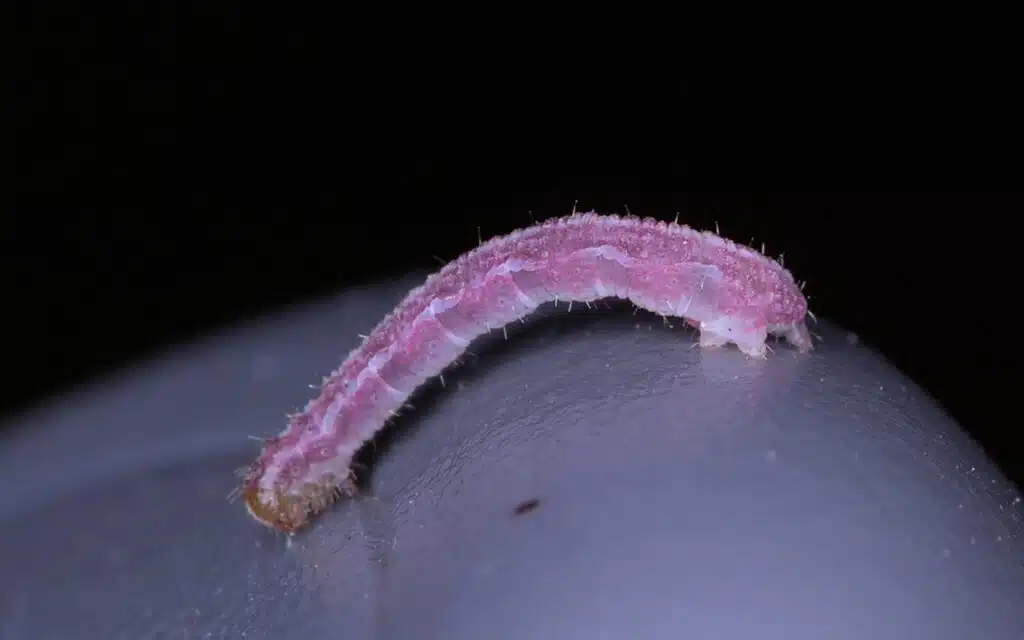
The pink-red Doubled-striped Pug Caterpillar (Gymnoscelis rufifasciata) poses a specific threat to roses as it appears in up to 3 broods per year.
It has a slightly translucent appearance or a light nuance on the sides with dark dorsal coloring.
July marks the debut of its first brood. The species has at least one more brood, depending on the season.
Double-striped Pug Caterpillars aren’t exclusively feeding on plant leaves.
They can also eat all types of caterpillars from other species sharing the same host.
Gardens and orchards are some of the ideal habitats for the species that feed on rose leaves, raspberry leaves, and even on tomatoes.
Its pest status is serious in gardens.
Unlike other caterpillars, Double-striped Pug Caterpillars don’t eat hardwood tree leaves.
8. Small Engrailed Caterpillar
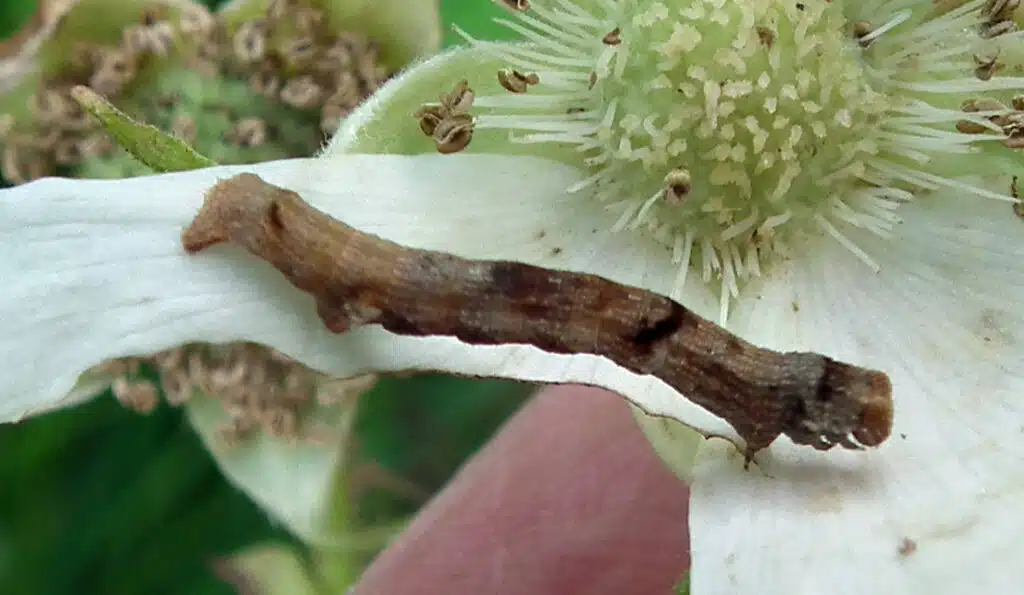
This gray, brown, or yellow caterpillar (Ectropis crepuscularia) is known for mimicking twigs and looking like part of the plant.
Its appearance makes it almost not visible to its predators. A high number of Small Engrailed Caterpillars can be spotted in the same place as a result.
Most importantly, the high numbers of Small Engrailed Caterpillars in a habitat are also influenced by the almost endless number of hosts.
Apart from roses, it also feeds on other flowers, legumes, and on tree leaves.
Found at different altitudes, the species migrates from rose-family plants to other hosts such as balsam fir.
Small Engrailed Caterpillars are seen in either 1 or 2 broods each year.
The second brood of the species overwinters in a pupal stage resuming its lifecycle in the spring.
Mid to end summer months mark the period Small Engrailed Caterpillars are the most damaging in North America.
9. Winter Moth Caterpillar
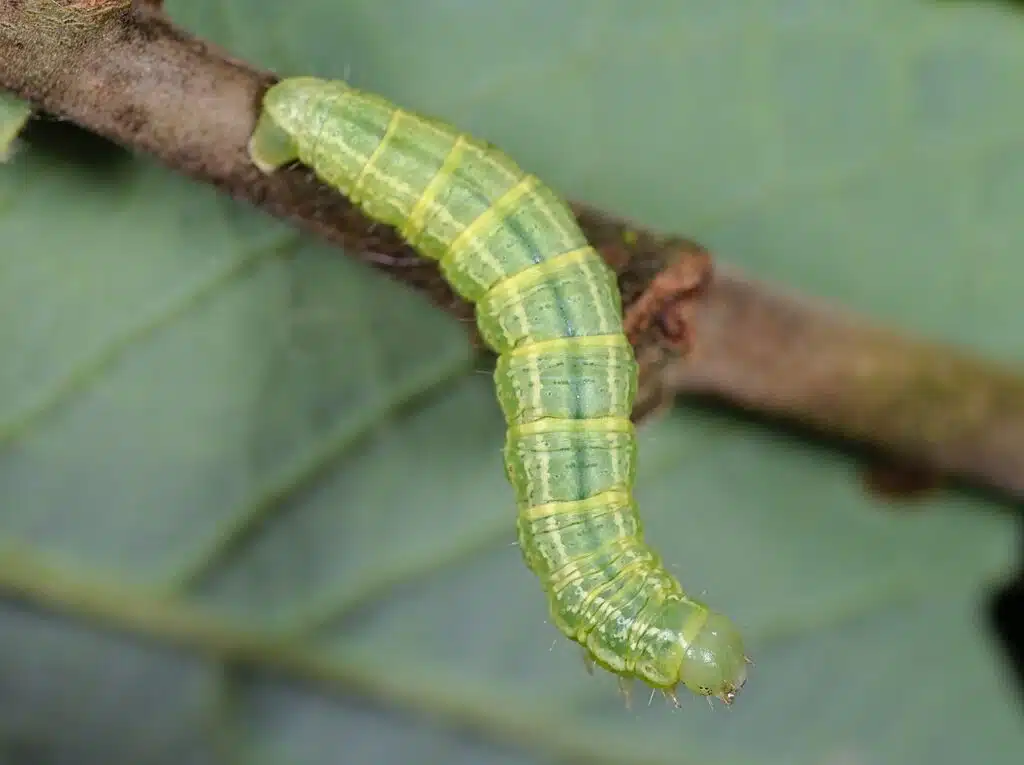
Winter Moth Caterpillars (Operophtera brumata) are an introduced species in North America. A European native, this species has made its way and established itself in multiple US states.
The color of the species is green. A uniform color with green prolegs is specific to this species.
Taking the caterpillars seriously is recommended as it can damage roses and other plants and even trees in the garden.
Rose is impacted by the caterpillar but its main preferences include birch, beech, and chestnut.
Almost any type of leafy host can be a suitable choice for the adult moths to lay eggs on in the absence of these common hosts.
Parasitic wasps are some of the most common natural enemies of the species.
Insecticide is widely used against Winter Moth caterpillars.
10. Brown-tail Moth Caterpillar
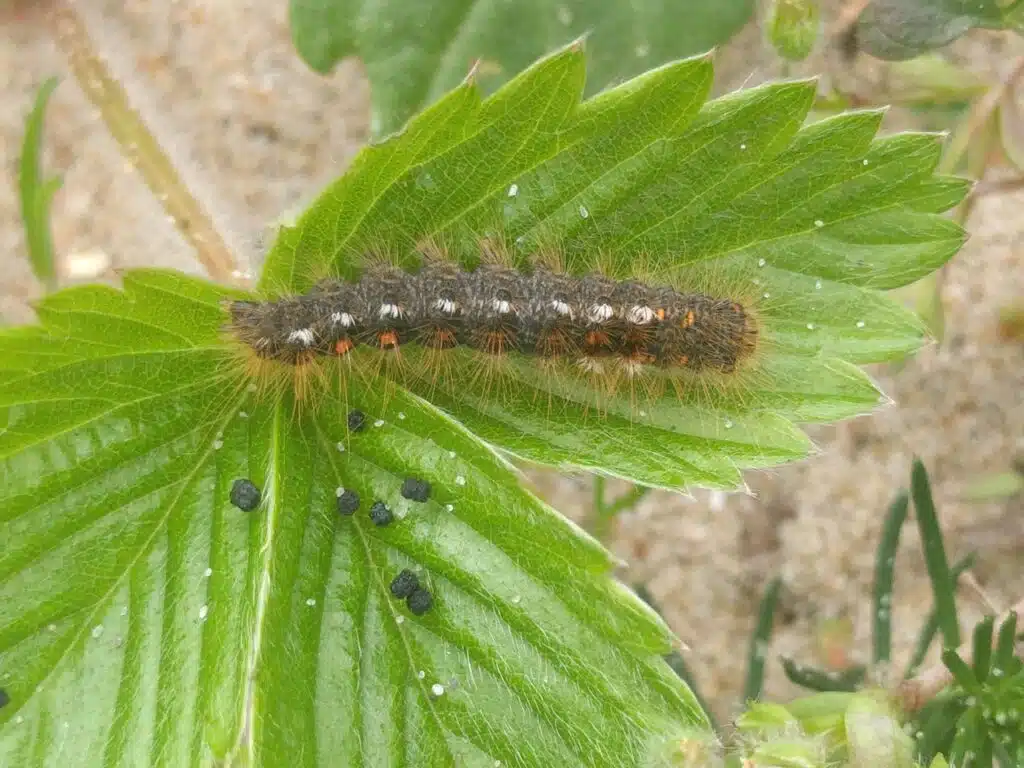
A multi-colored appearance is specific to this caterpillar (Euproctis chrysorrhoea) which has orange-brown dorsal coloring towards its anal plate, which inspires its name.
Brown-tail Moth Caterpillars have been living in North America for more than a century.
At this time, its pest status has only been confirmed.
A serious pest, Brown-tail Moth Caterpillars always show potential for outbreaks.
Research shows the species defoliates its host easily. It then moves to almost any other plant, flower, shrub, legume, or tree for more food.
Initial growth stages mark a period when the Brown-tail Moth Caterpillar feeds in groups.
This period also marks the highest outbreak risk and the period to take action before the species kills its rose host.
Caterpillars of this species may drop to the ground and move either to another rose plant or to a nearby tree such as a maple or pear for feeding.
Pesticides are used against the species for full control.
You need to spray roses and other plants with pesticides in May before the caterpillar starts to overtake its host.
It’s always best to remove these caterpillars with a gardening hose in case of an outbreak.
Small urticating yellow hairs grow on the Brown-tail Moth Caterpillar. This means handling the species leads to mild or severe skin rashes so direct contact isn’t advisable.
11. Mouse Moth Caterpillar
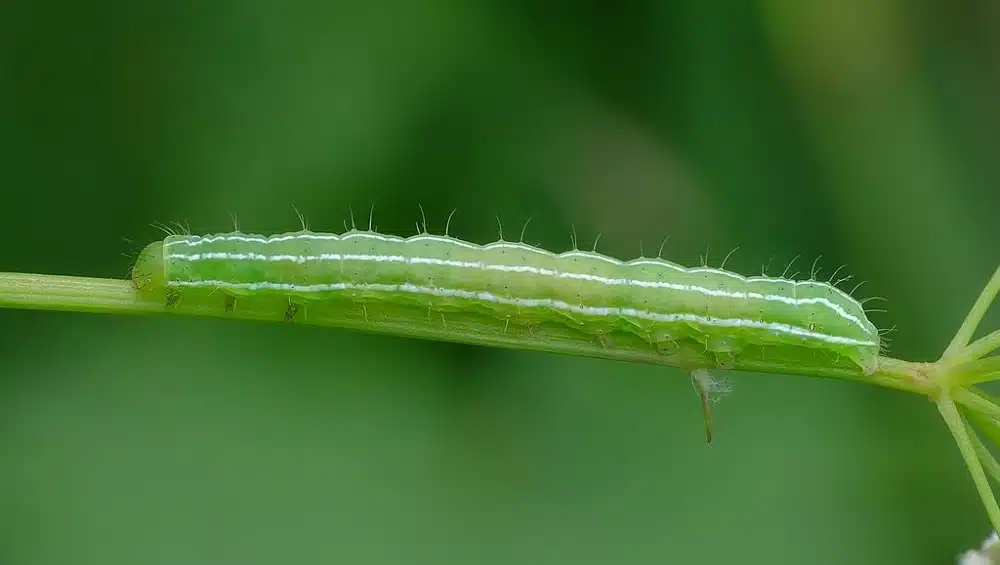
Mouse Moth Caterpillars (Amphipyra tragopoginis) emerge in the spring after overwintering as spherical-shaped eggs.
The emerged species has green coloring. As it grows, it also shows yellow side stripes.
Grown caterpillars eventually become yellow and brown.
These types of caterpillars feed both on the rose flower itself and on its leaves, which makes them a species that needs to be eliminated.
Its number of hosts is considerably higher in Northern US and Southern Canada territories around water where willows and nettle grow.
This species can easily migrate to crops as it impacts tobacco and parsley just as much as roses.
Those with strawberries in the garden should also know the species can feed on smaller plants as well.
Migration to trees is possible in the species even outside willow as it has been found on different species of oak.
In general, even adult moths of the species are found around plants rich in nectar.
12. White-dotted Prominent Caterpillar
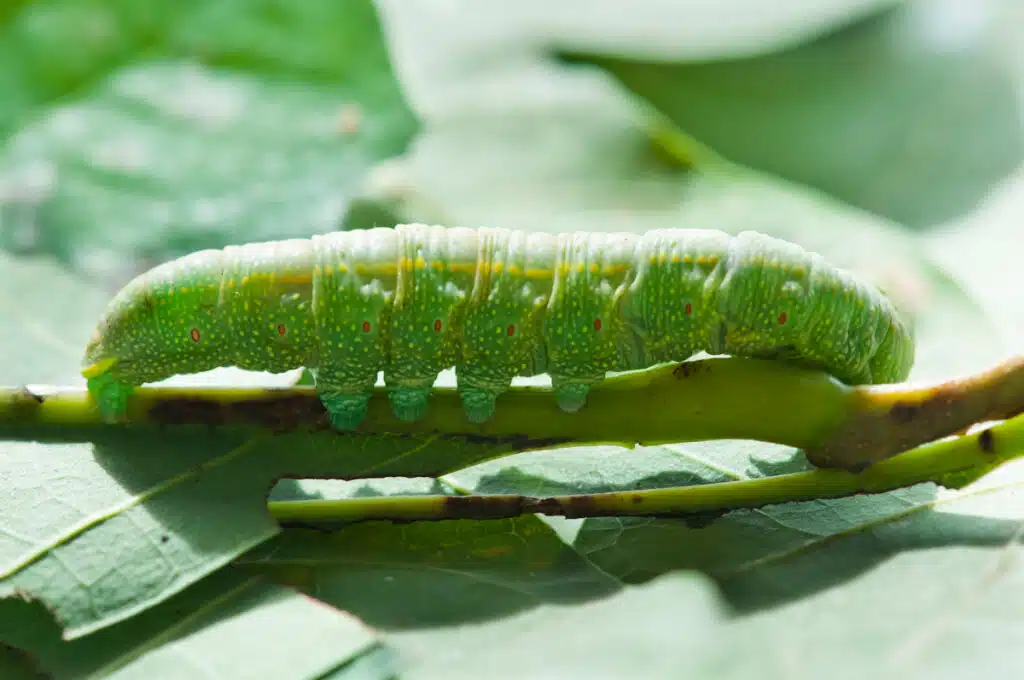
A light green color is specific to the early days of the White-dotted Prominent Caterpillar (Nadata gibbosa).
This species is named after the tiny white dots that cover its body through almost all of its life stages.
The White-dotted Prominent Caterpillar then becomes brown or dark brown into its final growth stages before pupating.
A high appetite is tied to this species. Also known as The Green Oak Caterpillar, this species favors oak leaves but it makes its way to rose, cherry, and other types of trees such as willow as well.
Its natural habitat includes vast regions East of The Rocky Mountains.
Western regions of North America have also seen the presence of this species which means it covers most of the US and Canada where it has a risk of outbreaks.
13. Morning-glory Prominent Caterpillar
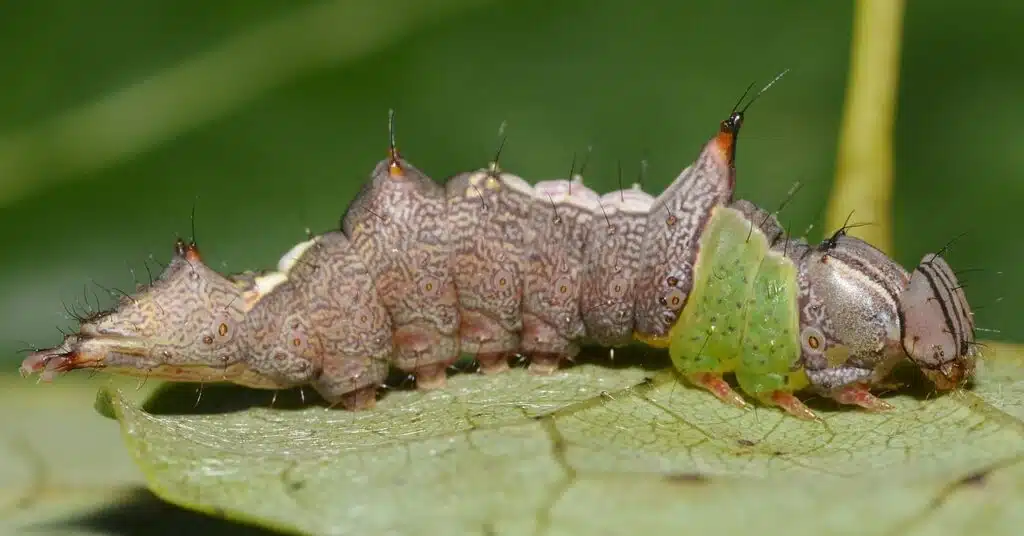
Morning-glory Prominent Caterpillars (Schizura ipomaeae) appear in the spring. The end of March and the beginning of April are periods when the species is first active after overwintering.
Feeding on various rosa-type plants, this caterpillar is known for having camouflaging colors.
Its distinct coloring makes it appear as a dried part of a green leaf.
The upper body of the caterpillar is green. Its head is gray while the lower part of its body and much of its dorsal coloring is brown, mimicking a dried leaf.
The shape of the body isn’t purely cylindrical as with most caterpillars. It has an irregular shape, further mimicking leaves.
Damages inflicted by this species can be seen as considerable as it can eat its way even through leaf veins apart from the softer part of the leaves.
The pest status of this caterpillar needs to be taken seriously as it can impact other types of flowers, plants, and trees around.
Morning glories are some of the most commonly affected flowers besides roses.
Furthermore, a series of trees such as beech, elm, and oak are also impacted and almost defoliated by a growing number of caterpillars.
Initial signs of a possible invasion include seeing just a few caterpillars on host roses or noticing white spots on the leaves of roses.
These white spots can come with or without perforation but they indicate the caterpillar has fed on a particular leaf.
14. Stinging Rose Moth Caterpillar
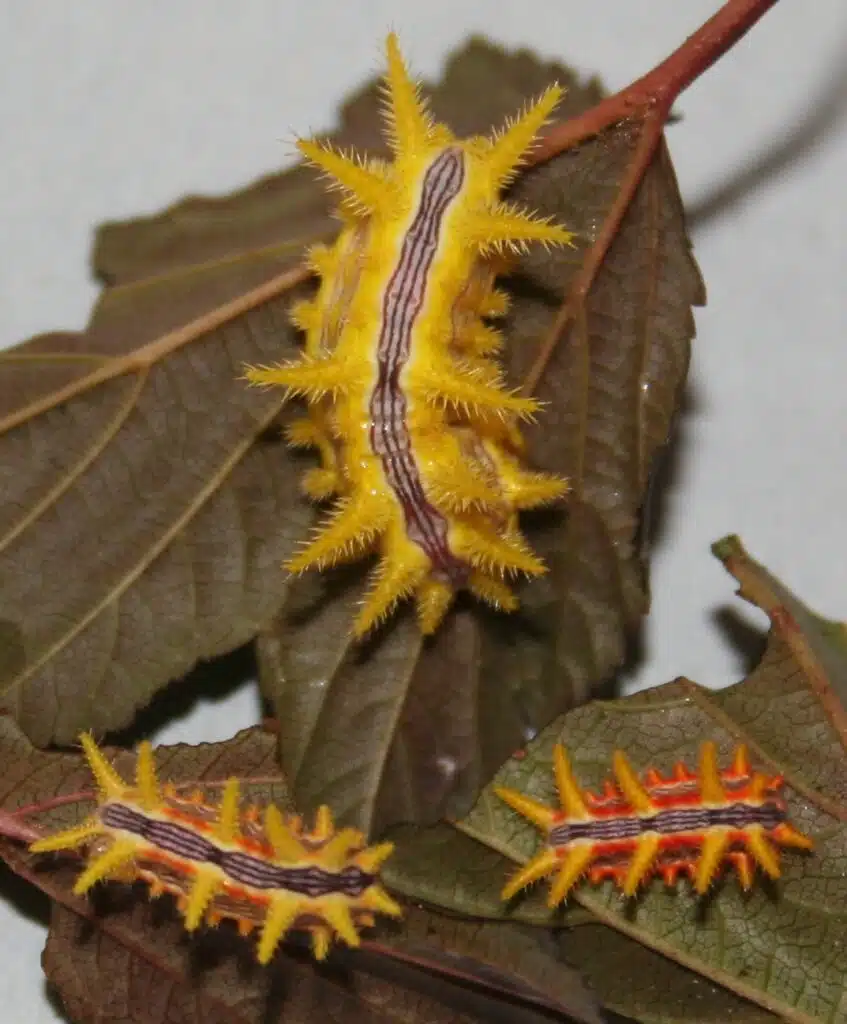
Present in North America, this type of caterpillar (Parasa indetermina) is named after its stinging tubercles which can inflict pain and skin reactions such as urticaria.
Venom glands are found on this caterpillar. These glands are connected to its tubercles which means touching the caterpillar from almost any angle exposes the skin to its urticating venom.
Stinging Rose Moth Caterpillars are a threatened species in many of their traditional habitats such as those around Northeastern parts of the United States.
Red, orange, and black colors are specific to this striped species. Its spines are yellow and aim to keep predators away.
The species tends to be most problematic to roses at the end of the summer or in early fall when its numbers are the highest.
Management plans are required against this species for roses growing in Southeastern parts of the US. This is the habitat where the species is most common.
Apart from roses, the species can migrate to other hosts such as dogwood and hickory.
15. Forest Tent Caterpillar
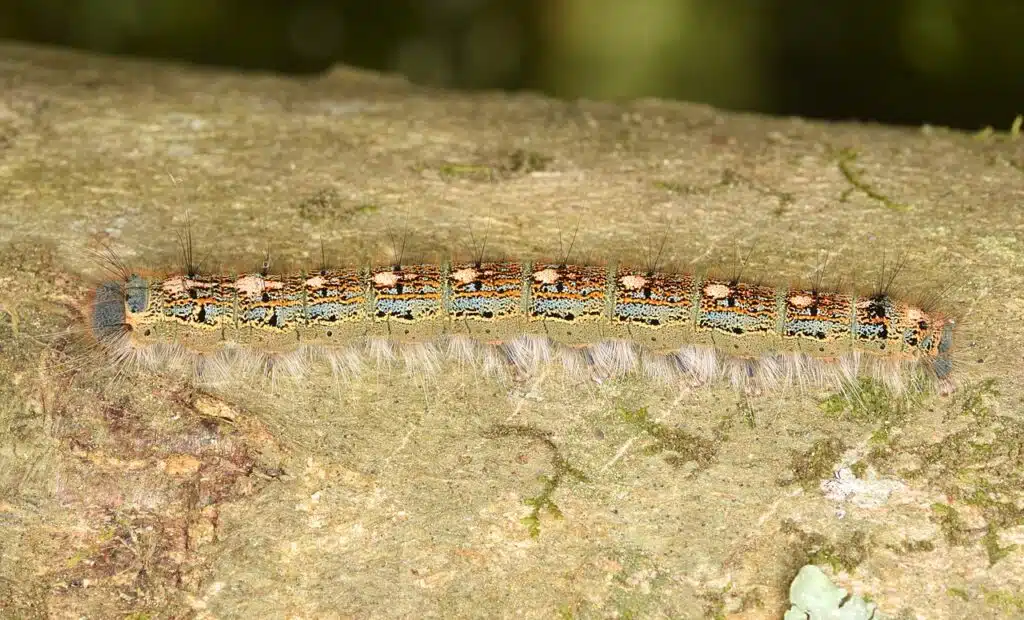
Forest Tent Caterpillars (Malacosoma disstria) are some of the most important rose and tree pests in Northeastern US territories.
Serious outbreaks of the species are cyclical. Outbreaks can happen even in 2 or 4 years with events unfolding even every decade.
There’s no evidence to show why the caterpillar has rare but considerable outbreaks.
During these periods, the species defoliates roses and even all types of hardwood trees in its path.
Identification is based on its black color with vivid contrastinb blue dorsal stripe. This blue stripe is bordered by white dots.
Fine yellow stripes also run alongside the central dorsal blue stripe.
Removing these caterpillars from host flowers is easier in their first instars or initial growth stages.
This is a time when all of the young caterpillars live and feed in groups.
Research shows this is a technique to avoid predators.
Once they reach their fourth instar, these caterpillars start to either disperse on their own or even move hosts.
16. Sawfly Larvae
Both wild and cultivated roses are impacted by different types of sawfly larvae.
Different types of Sawfly Larvae feed on roses. Many are yellow or green and have a similar appearance.
Largely referred to as Sawfly Larvae, these caterpillars comprise different subspecies.
- Curled Rose Sawfly
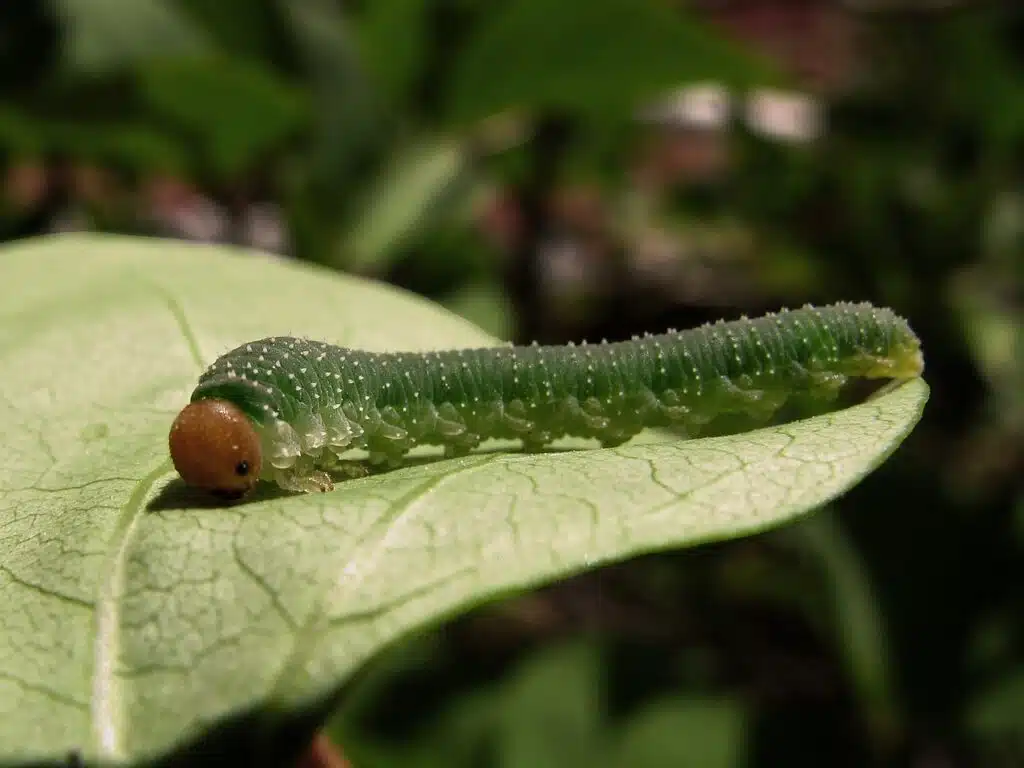
This pale green caterpillar (Allantus cinctus)has rare short white hairs covering its body.
It feeds on rose leaves with a considerable impact on the host plant.
Complete rose defoliation is specific to this species. While young Curled Rose Sawfly Caterpillars only eat the softer parts of the leaves, grown caterpillars eat the entire leaf.
- Bristly Rose Sawfly
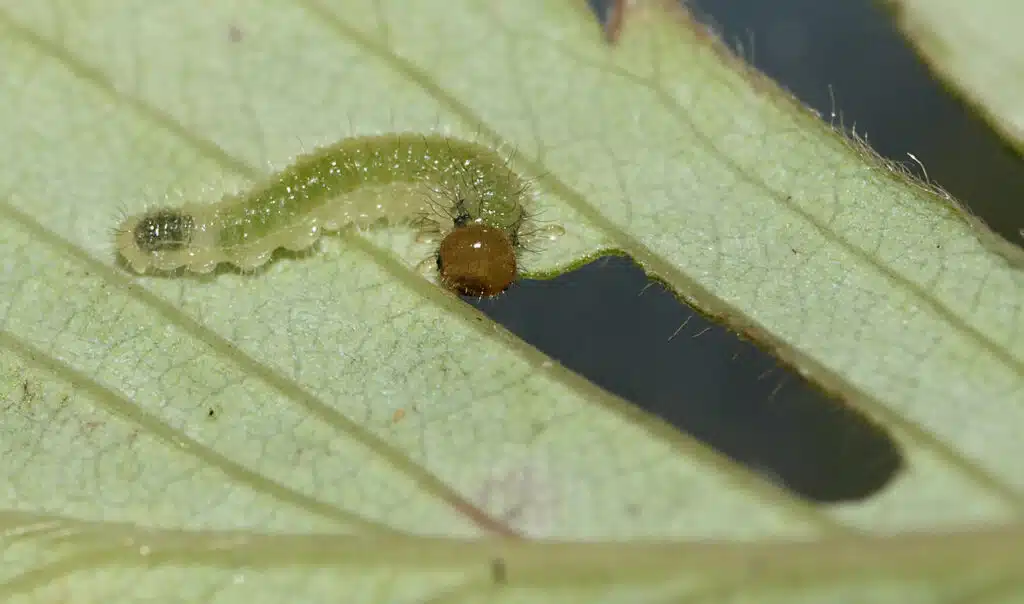
Bristly Rose Sawfly Caterpillars (Cladius pectinicornis)are very similar to Curled Rose Sawflies.
The species can be differentiated by its slightly wider body compared to the Curled Rose Sawfly Caterpillar.
Apart from coloring, eating habits are also similar in these species. Bristly Rose Sawfly Caterpillars feed on rose leaves and strawberry leaves.
How to Get Rid of Caterpillars on Roses
Getting rid of caterpillars on roses is mandatory when it comes to limiting plant health issues.
Preventive measures are recommended as caterpillars might have already consumed rose leaves whenever spotted on a host.
Here’s how to get rid of caterpillars once you see them on your roses.
Sprinkle chili powder around plants
Chili powder sprinkled around roses is believed to be one of the non-invasive methods of deterring caterpillars.
It’s believed the pungent aroma of the powder makes caterpillars fall off their host to move along before they die in the absence of a host.
This method might need to be repeated after windy days as the powder might get spread out.
Use a gardening hose to remove caterpillars
A blast of water is sufficient to remove most caterpillars from host rose plants.
Avoiding pressure washers is best as they damage most types of rosacea-family plants.
Watering roses also reveals the types of caterpillars that might be hiding on the underside of host plant leaves.
Spray imidacloprid pesticides on roses
Not all pesticides are good for roses. Pesticides based on imidacloprid are recommended as they don’t impact roses.
Pesticides are the complete solution against caterpillars as they also keep adult moths from laying eggs on the host plants.
Prevention techniques
Keeping caterpillars away is at least as important as removing them once spotted on roses in the garden.
Non-invasive preventive measures that aren’t based on chemicals are recommended against rose-eating caterpillars.
Spray preventive essential oils
Fragrant essential oils sprays such as those with lavender oil mixed with lukewarm water are used to prevent caterpillars and moths on roses.
Plants need to be coated in essential oils so that the aromatic fragrances deter moths and butterflies before they lay eggs which turn into caterpillars.
Plant garlic in-between roses
Garlic is one of the natural solutions against caterpillars when planted in-between roses.
Planting garlic is recommended when you live in an area known to attract caterpillars.
You can consider planting garlic when your roses have been previously impacted by caterpillars.
Garlic also repels other species such as horn flies and ticks.